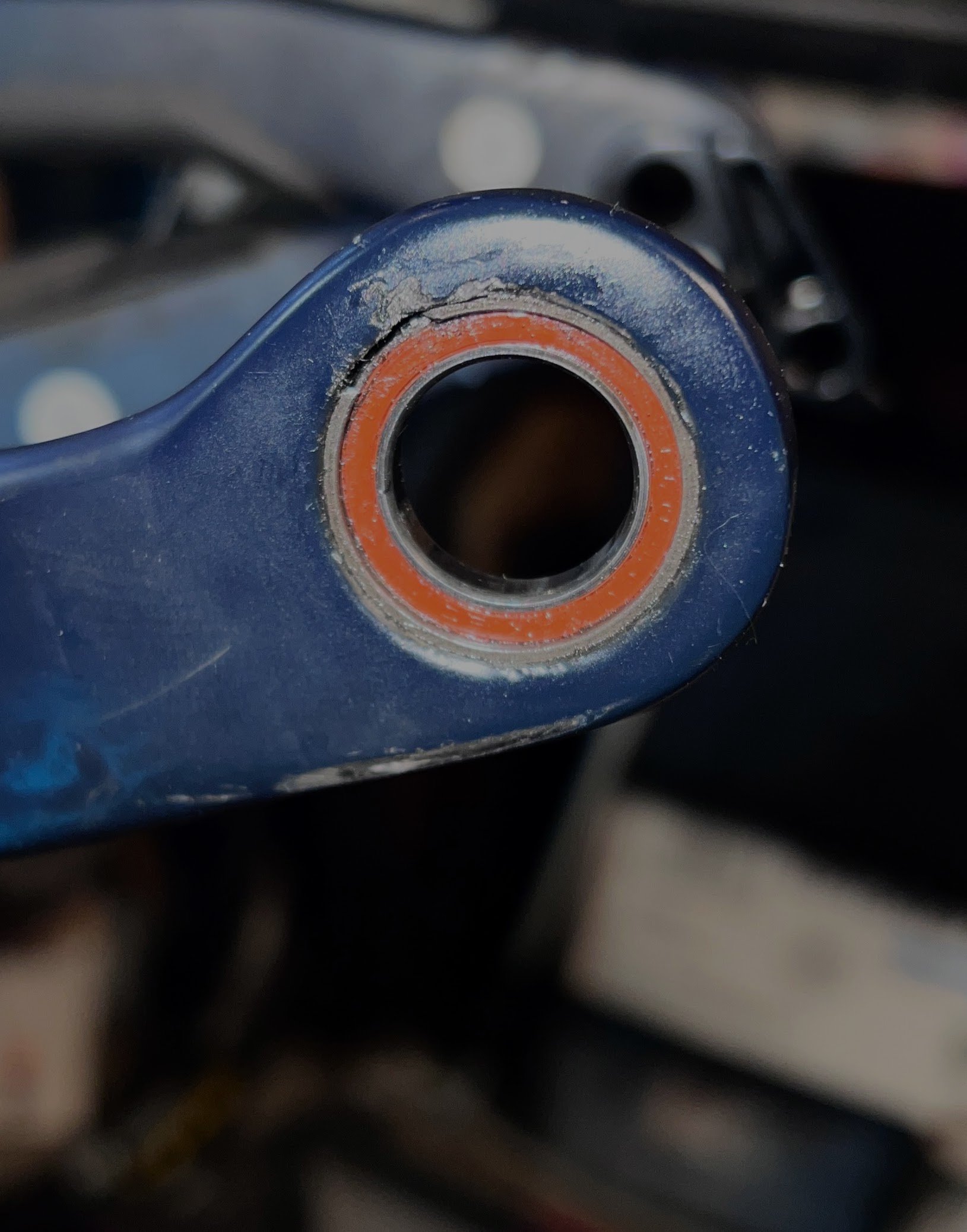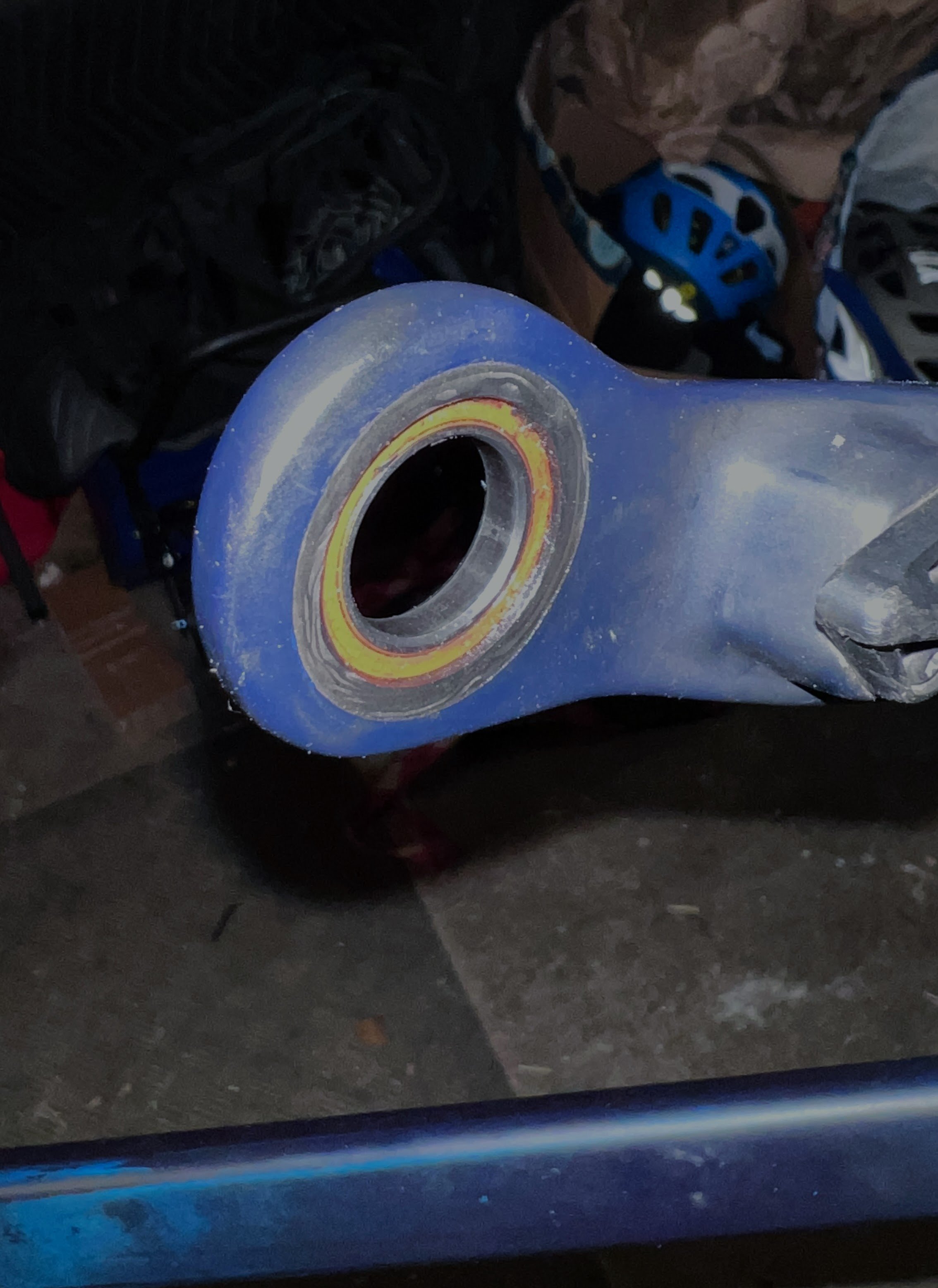Rod B.
Well-known member
- Thread starter
- #31
sgtcurry,
I agree with Rich, I would grease the lower pivot axle just to eliminate it from the noise isolation process.
What you are describing sounds like a rear hub bearing or possibly a cassette freehub bearing may be going bad. The drive side hub bearing and the cassette freehub bearings tend to take a serious beating from the torque that an electric motor produces. My I9 Hydra hubs had only 1,200 miles on them when the drive side rear hub bearing went bad.
What type of rear hub do you have? Does the noise only occur while pedaling? When a rear hub bearing starts going bad, it will make a can full of gravel noise while pedaling. When a freehub/driver goes bad, it will start making a noise while pedaling under a serious load, i.e. steep and punchy climb. Most rear hub bearing noises typically occur only while pedaling and will get gradually worse/louder, the longer you ride on the worn out bearing.
1) Check your rear hub bearings: Take the rear wheel off and insert the rear axle back into the hub. Hold the rear wheel at port arms by gripping the axle and end caps on each side of the hub solidly. With a finger, flick a spoke and slowly spin the rear wheel. Do you feel any vibration or a bumpy notchy feeling? The wheel should spin smoothly with absolutely no vibration/bumpy feeling. If you do feel vibration, you have a rear hub bearing going bad. Manually check each bearing with your finger to see which one needs to be replaced.
Note: The only caveat to this is if you have a Shimano rear hub and it has cup/cone ball bearings, i.e. Deore hubs on the Rise M20. Shimano hubs with cup and cone bearings will feel rough. If your rear hub has cartridge bearings, it should spin very smoothly, no vibration.
To check rear hub's freehub or driver bearings, place the rear wheel upright on a bench. Grip the cassette and firmly place a load on it with your hands while turning it. Do you feel any play, rocking, grinding, etc. The cassette should spin easily and solidly. There should be no grinding or play. Another way to check a freehub or driver is to remove cassette. Remove the freehub/driver and manually check the bearings with your finger to see if they have a rough notchy feeling when you spin them. I've yet to rebuild a Shimano Micro-spline freehub so I'm not familiar with the bearing setup. If it's a SRAM XD freehub driver, it will have an inner and outer bearing.
Secondary checks:
2) Check the cassette: Slowly rotate the cassette. Examine the teeth on the cogs. Are any missing? If you have a SRAM cassette, pay particular attention to the teeth directly above each shift ramp on the largest cog. They are the weakest and will tend to break off if you miss a shift, especially in boost mode. Lastly, with the bike in a repair stand, turn the cranks and watch the cassette as it turns. Do the cassette cogs all spin straight and true? Are any of the cogs bent and out of alignment?
3) Check the chain for a bent chain link: To do this place the bike on a repair stand. With your hand slowly spin the rear wheel backwards. Watch the chain as it slowly travels over the upper pulley. If you have a bent chain link, it will jump a bit as it travels over the smaller upper pulley. This is due to the bent chain link binding and not being able to fully bend over the smaller upper pulley.
4) Check your rear derailleur upper and lower pulleys: On eBikes, the nylon upper pulley will tend to wear out quicker than the lower pulley.. Make sure nothing out of the ordinary is going on with the pulleys, i.e. missing teeth or a cracked pulley. Next, shift the bike to the smallest cassette cog. Pull the derailleur arm forward to unweight the chain. Pull the chain away from the upper pulley and spin it. Does it spin freely? Do the same with the lower pulley, does it spin freely? If they don't, the pulley bearings need to be cleaned and greased.
Let me know how you make out.
Be safe,
Rod
I agree with Rich, I would grease the lower pivot axle just to eliminate it from the noise isolation process.
What you are describing sounds like a rear hub bearing or possibly a cassette freehub bearing may be going bad. The drive side hub bearing and the cassette freehub bearings tend to take a serious beating from the torque that an electric motor produces. My I9 Hydra hubs had only 1,200 miles on them when the drive side rear hub bearing went bad.
What type of rear hub do you have? Does the noise only occur while pedaling? When a rear hub bearing starts going bad, it will make a can full of gravel noise while pedaling. When a freehub/driver goes bad, it will start making a noise while pedaling under a serious load, i.e. steep and punchy climb. Most rear hub bearing noises typically occur only while pedaling and will get gradually worse/louder, the longer you ride on the worn out bearing.
1) Check your rear hub bearings: Take the rear wheel off and insert the rear axle back into the hub. Hold the rear wheel at port arms by gripping the axle and end caps on each side of the hub solidly. With a finger, flick a spoke and slowly spin the rear wheel. Do you feel any vibration or a bumpy notchy feeling? The wheel should spin smoothly with absolutely no vibration/bumpy feeling. If you do feel vibration, you have a rear hub bearing going bad. Manually check each bearing with your finger to see which one needs to be replaced.
Note: The only caveat to this is if you have a Shimano rear hub and it has cup/cone ball bearings, i.e. Deore hubs on the Rise M20. Shimano hubs with cup and cone bearings will feel rough. If your rear hub has cartridge bearings, it should spin very smoothly, no vibration.
To check rear hub's freehub or driver bearings, place the rear wheel upright on a bench. Grip the cassette and firmly place a load on it with your hands while turning it. Do you feel any play, rocking, grinding, etc. The cassette should spin easily and solidly. There should be no grinding or play. Another way to check a freehub or driver is to remove cassette. Remove the freehub/driver and manually check the bearings with your finger to see if they have a rough notchy feeling when you spin them. I've yet to rebuild a Shimano Micro-spline freehub so I'm not familiar with the bearing setup. If it's a SRAM XD freehub driver, it will have an inner and outer bearing.
Secondary checks:
2) Check the cassette: Slowly rotate the cassette. Examine the teeth on the cogs. Are any missing? If you have a SRAM cassette, pay particular attention to the teeth directly above each shift ramp on the largest cog. They are the weakest and will tend to break off if you miss a shift, especially in boost mode. Lastly, with the bike in a repair stand, turn the cranks and watch the cassette as it turns. Do the cassette cogs all spin straight and true? Are any of the cogs bent and out of alignment?
3) Check the chain for a bent chain link: To do this place the bike on a repair stand. With your hand slowly spin the rear wheel backwards. Watch the chain as it slowly travels over the upper pulley. If you have a bent chain link, it will jump a bit as it travels over the smaller upper pulley. This is due to the bent chain link binding and not being able to fully bend over the smaller upper pulley.
4) Check your rear derailleur upper and lower pulleys: On eBikes, the nylon upper pulley will tend to wear out quicker than the lower pulley.. Make sure nothing out of the ordinary is going on with the pulleys, i.e. missing teeth or a cracked pulley. Next, shift the bike to the smallest cassette cog. Pull the derailleur arm forward to unweight the chain. Pull the chain away from the upper pulley and spin it. Does it spin freely? Do the same with the lower pulley, does it spin freely? If they don't, the pulley bearings need to be cleaned and greased.
Let me know how you make out.
Be safe,
Rod



